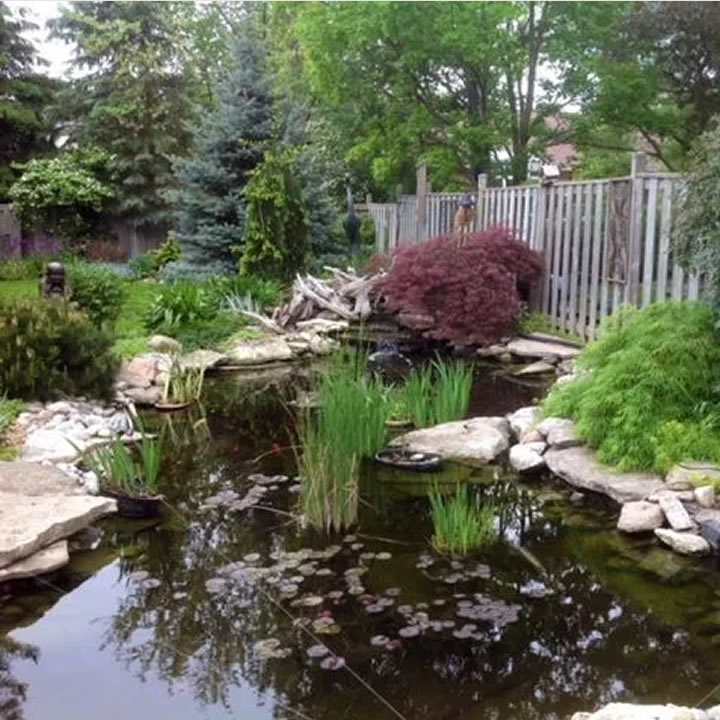For a backyard pond to stay clean and healthy over time, it needs a regular supply of oxygen. An aeration system is an essential part of your pond. If you have live fish and plants, too little oxygen in the water can kill them. On a more basic level, an aeration system keeps the pond water clean, minimizing algal blooms and organic sludge. It also ensures that your pond doesn’t smell, regardless of the weather or anything that might fall into it. Some aeration systems such as fountains can even add to the beauty of your pond, combining aesthetics with functionality.
Without aeration, maintaining a pond will be much more difficult, not to mention that the ecosystem can quickly turn imbalanced. But before you can go ahead and get an aeration system, weigh several factors first. The right aeration system for you depends on the dimensions and main purpose of your pond, along with how much you’re willing to spend on it.
Popular Aeration Systems
These two aeration systems are the most popular:
Fountain Aerator
A fountain aerator is a great choice for decorative ponds because of its strong visual impact. Simply put, it does the double job of generating a fountain out of your pond while renewing the oxygen supply.
Its main component is a water pump floating on the pond surface. The pump sucks in the pond water around it, then blows it out into the air through a nozzle, creating a lovely fountain effect. While the water is in the air, it attaches to new oxygen molecules and brings these back into the pond as it crashes down.
The fountain aerator is best suited for ponds that are shallower than 6 feet, with a symmetrical shape. Although it’s very efficient, it only aerates the water around the floating pump, which means the fresh oxygen extends to around 3-4 feet into the pond but not further than that. On the other hand, it pushes algae and debris to the edges of the pond so they’re easier to remove. To make it even more stunning, you can combine it with lights that glow at night.
Diffused Aerator
The other common type of aerator is the diffused aerator. Compared to the fountain, it’s not very visually striking, but it’s better at spreading oxygen around.
A diffused aerator is placed inside the pond, underwater, where it blows air out directly into the water. The basic setup consists of an air compressor, one or more diffusers, and a hose. Oxygen from the air is first sucked in through the compressor, which is placed on land near the pond. The air passes through the hose into the diffuser inside the pond. In turn, the diffuser releases air bubbles, which push up the water around it into the surface. This forces the water to constantly circulate, removing bad gases.
The larger your pond, the more diffusers you will need. Diffused aerators are usually electricity-powered so there’s a power source that can be as far as ¼ mile away.
Alternative-Energy Aeration Systems
For sustainability and more cost savings over time, you can turn to aerators powered by alternative energy:
Solar Aerator
Because solar aerators rely on sunlight rather than electricity, you don’t have to worry about having a nearby electric source or even constant bills. A solar aerator pretty much has the same components as an electricity-powered one, except that it gets its energy from a solar panel. It’s also convenient because it runs automatically, requiring little effort from you.
A solar aerator on average runs around 15 hours per day in good weather, which is usually enough for a pond. This is because it can’t absorb enough sunlight during evenings or extremely cloudy days. With a battery, though, it can aerate for 20 hours per day.
Windmill Aerator
Like solar aerators, windmill aerators are environmentally friendly. They’re rarer, larger, and more difficult to install, but they work well for remote locations. In addition, when the windmill is placed on a high altitude so it can gather a lot of wind, it can aerate ponds as big as 12 acres in size.
How it works is the air currents cause a windmill’s blades to move. These blades control a rotor, the movement of which is turned into electricity. The limitation of windmill aerators is they’re dependent on wind, so aeration can be uneven depending on the time of day.
What to Choose?
With these basic types of aeration systems, a simple rule of thumb is to choose a fountain aerator if you have a smaller pond and want strong visual impact. On the other hand, a diffused aerator would be your choice if you want maximum aeration. Many pond owners combine both for the best of both worlds. For sustainable options, you can always consider solar or windmill aerators.
Aeration systems can actually be purchased online, with hassle-free delivery. Some stores like Living Water Aeration offer a huge number of different aeration systems, and most would be willing to guide you. Setting up a pond needs a lot of planning, so take your time when choosing which aeration system would suit your pond the most.

